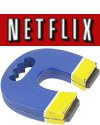Re-post: This article first appeared March 3, 2006.
As home entertainment evolves and subscriber acquisition costs grow, customer loyalty will have a greater profit impact

With more than 3 million subscribers (and climbing), Netflix is the leader in online DVD rentals. Founded in 1999 and rising out of the flames of the dot com bust, Netflix has earned a place among the country’s top home entertainment brands. With its tight focus and flawless execution, Netflix has made me an admirer. But as a customer since 2003, find myself strangely distant from and only loosely engaged with the brand. While the company aggressively pursues new subscribers, it seems curiously nonchalant about customer loyalty in the face of lurking competitive forces that include other DVD rental outlets, DVD sales outlets, on demand cable, broadband video content, computer games, and REAL LIFE, including work, school, family, and live entertainment.
Netflix does provide an enjoyable and useful website, which the company claims (credibly) as the industry leader in customer satisfaction. Yet beyond perfunctory email newsletters I’m unaware of any attempt by Netflix to engage me in other ways. I spend about 40 minutes each month updating my queue and reading reviews, and then I’m gone. I generally ignore Netflix emails, which lack content value. When I watch a DVD (about two each week), I perceive the branding on the mailing sleeve as I remove and reinsert the disc (and then return it to the mailbox), but the movie experience itself is only weakly associated with Netflix. (Where’s the Netflix splash screen?)
As much as I enjoy the service, Netflix ultimately falls low on my priority list. For Netflix this represents a risk in terms of my loyalty. I’m susceptible to both competitive offers and brand apathy. I might switch, or simply lapse as the home entertainment landscape evolves. This kind of weak brand attraction may be what put Netflix in an awkward position in 2004, when in April it announced it would raise its standard pricing from $19.95 to $21.95 and then in November flip-flopped by lowering the price to $17.99 under pressure from Blockbuster and Wal-Mart. When brand attraction is weak and the cost of switching is minimal, then price remains one of the few (and most unforgiving) competitive levers. At the time of the price cut, Netflix stock suffered a decline of more than 40 percent (from which it has recovered nicely).
It’s also possible that Netflix has become somewhat complacent with its apparently low subscriber churn. Netflix pegged its 2Q 2005 average monthly churn at 4.7 percent (vs. 5.0 percent for 1Q), which sounds great but still represents approximately 529,000 cancellations in the quarter. (Netflix, like many companies, has its own “churn” formula, which it defines as “customer cancellations in the quarter divided by the sum of beginning subscribers and gross subscriber additions, divided by three.”) While the company added 707,000 new subscribers in the same period for a net increase of 178,000, the cancellations are nothing to sneeze at. At this level, Netflix churns more than half of its subscribers every 12 months. And therein lies the challenge. Conventional wisdom says that it costs less to keep a customer than to find a new one, yet while Netflix may defy conventional wisdom in the short term through aggressive new sub acquisition, in the long term it must create new ways to strengthen its brand attraction. By its own account, in 2Q 2005 the cost to acquire a new subscriber increased 6 percent versus the same period in 2004. On the operational side, Netflix has the added complication of sensitivity to postal rates, which could rise in 2006 and 2007, depending on the outcome of postal reform legislation in Congress.
My meandering detour through the numbers juxtaposes the facts of Netflix’s astounding success with indicators of potential hazard. The consequence boils down to customer profitability: if pricing remains sensitive to external pressure while acquisition costs continue to increase as the market matures, then customer loyalty, i.e., brand attraction, becomes a key lever for both profitability and the ability to introduce new high-growth products.
The lack of a Netflix effort to engage me beyond the website and a few emails suggests over-reliance on new subscriber acquisition, and perhaps a classic dot-com online-only bias. If Netflix aspires to reduce churn further and increase revenue per subscriber, it must consider specific strategies or programs beyond the website and email. One approach could be to reimagine a Netflix subscription as membership in a club (not unlike the Auto Club), with membership-oriented benefits such as print publications, discounts, and events. Another approach could be to reposition Netflix as a full service media company, offering exclusive and/or original content as a way to transition into broadband delivery. Of course, a growing, tightly focused, and profitable business such as Netflix is an attractive merger or acquisition prospect. But even if Netflix hopes for nothing more than to be acquired, increasing brand attraction can only enhance stakeholder value. END
Sidebar: Breaking the Mold While Keeping the Brand Promise
Netflix has demonstrated remarkable sensitivity to its subscribers’ needs. I receive DVDs the day after they ship. My DVDs arrive in a package uncluttered by advertising. And I receive essential emails only. When a DVD I mailed was lost, Netflix apologized to me for my inconvenience. There was no interrogation or penalty. These high standards provide a competitive advantage, but at the same time, they represent a challenge by limiting the new products, partners, and communications the company can introduce to the brand community. Deviation from the brand promise can trigger brand community resistance or backlash, such as when Porsche introduced its low-end Boxter (sacrilege!), and later its Cayenne SUV (heresy!). (Do a web search for Porsche Boxter or Cayenne, and you’ll see what I mean.) Netflix has an advantage over Porsche in being able to test and refine new offerings over the course of a subscription. The key for Netflix is to use new offerings to increase the value that subscribers receive while resisting the temptation to simply monetize the subscriber database without adding value. – David M. Kalman
David M. Kalman is the president of Terrella Media, Inc. and editor of BrandMagnet.
